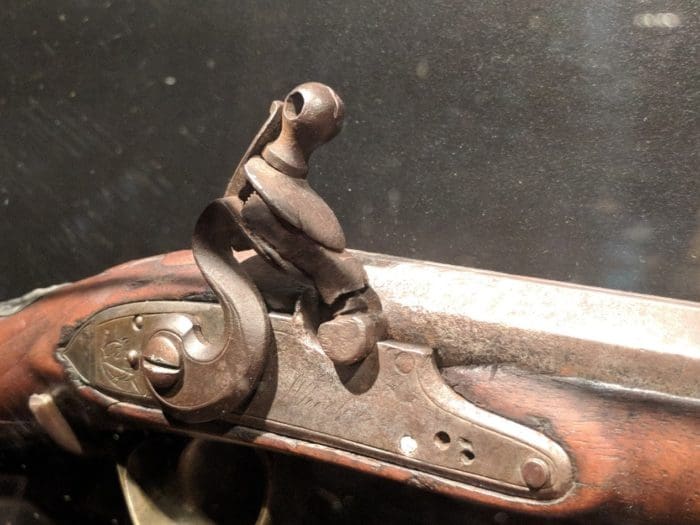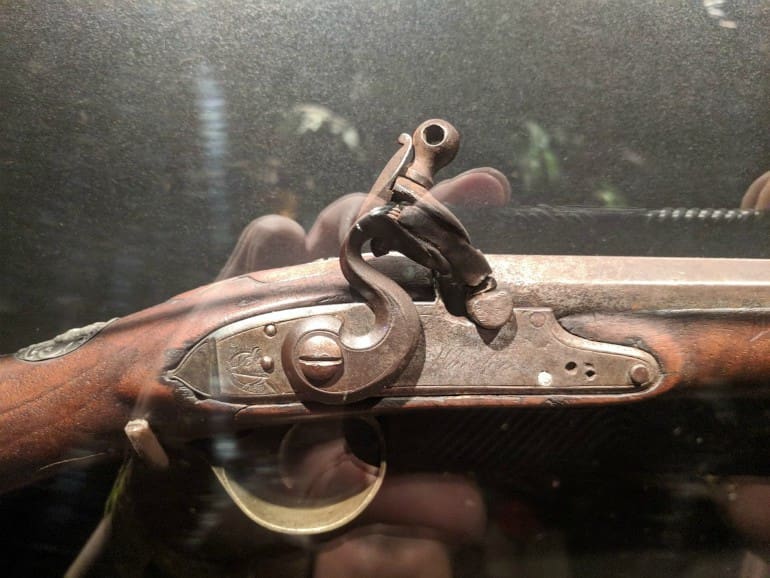Whenever I travel, I’m always on the hunt for a good museum. I can’t help it; the history nerd in me reigns supreme. Additionally, I’m always on the hunt for firearms of any kind in whatever museum I find. That was the case when I recently visited the Milwaukee Public Museum.
The MPM has been in possession of the world-class Nunemacher arms collection for a century or so. Within the collection is one of only two Ferguson rifles known to be in a collection that is publicly accessible. Unfortunately, the vast majority of Nunemacher’s collection isn’t on display and what is on display is simply used as set dressing for the larger dioramas.
Nonetheless, I was able to find some arms of interest – including this one.
It clearly started life as a flintlock and was crudely converted at a later date. Beyond that, I couldn’t glean anything more about the gun right then. So, I snapped a couple photos and filed it away in my brain to dig deeper once I got back home.
What I discovered is that the gun is what the Flayderman’s Guide refers to as a “Chief’s Grade Flintlock Trade Gun.” These arms were made specifically for presentation purposes to Indian chiefs as part of a treaty or other diplomatic offering between a tribe and the English. Defining features include a Native American armed with a bow and arrow in an oval attached to the gun’s wrist, and an image of a boar’s head and a curled hunting horn at the rear of the lockplate. They were made by a variety of different contractors and all have some slight variation.
This particular piece has a faint script engraving of “Wheeler” in front of the hammer on the lockplate. That means it was made by Robert Wheeler (1767-1813), who operated a gun shop in London. His is one of the many shops to have had a contract with the Hudson Bay Company to make these trade guns for them.

The percussion conversion is not a style that I had seen before. Granted, necessity is the mother of all invention and I’ve seen some pretty unusual conversion methods. This gun appears to have had the “first method” – also known as the French style – of conversion performed on it. This involves removal of the frizzen and its spring and the mounting of a drum in the vent hole. Mounted to the drum is a cone upon which a percussion cap is placed. A new, percussion-style hammer is then usually installed where the flintlock hammer had been located.
Such was not the case with this gun. Instead, the flintlock hammer was retained and a chunk of slightly curved metal was clamped into its jaws. This piece of metal had a face that was fashioned to properly strike and ignite the cap.
So while I was supremely disappointed that so very little of the Nunemacher collection was on display, I was delighted to see this piece because it added to my repertoire of percussion conversion methods and it led me to some research that I wouldn’t have otherwise done. All in all, a successful visit, I’d say.
Logan Metesh is a firearms historian and consultant who runs High Caliber History LLC. Click here for a free 3-page download with tips about caring for your antique and collectible firearms.





Should have gone the whole nine yards and converted to Creedmoor. Just saying.
Isn’t that about enough of the Creedmoor crap? Seriously? It’s really getting old…
To be fair, TTAG started it with that .308 bash article.
Thanks, I was wondering what the joke was. However, I agree with the other post, it is getting old.
Suzy don’t be a snowflake just because your sacred ox is gored. Comparatively.308 has some + 6.5CM has a lot of +. Get over it it’s not 1952.
If only we could create a bullet with a high enough ‘ballistic coefficient’ we wouldn’t need to fill the case with powder. Just looking at the bullet would kill a moose at 1,000 yds.
6.5×914,400 Creedmoar…
The Indians loved this firearm, they found they could substitute grains of sand instead of the .9 mm lead balls the white man was selling
I’d love to shoot a Furgeson rifle.
Louis L’Amore wrote a great book on the Furgeson.
Unfortunately. nearly all US museums fall into the “story telling” abyss where they assume that ALL patrons are as historically illiterate as Barry Saetoro. They lock 99% of their collection of neat stuff in to Raiders of the Lost Ark basement to collect dust. Some nitwitt constructs silly vignettes showing life on the _______________. Boob bate for Buffy.
Rock Island Arsenal has a very good REAL/traditional museum with rows of small arms of all types. Pretty interesting outside artillery park also.
One place that doesn’t do that is the Springfield Armory museum in Springfield, MA. (Not the company that purchased the name for those who don’t know) They have everything from original equipment to the experimental and test weapons. One of the guys that worked there was into guns and we had a nice conversation about Garands.
Go to the Cody Firearms Museum in Cody, Wyoming; it would take a month to see everything, and they a doubling it’s size. Truly mind boggling.
The Milwaukee Museum has some of the most beautiful weapons you could ask to see. The city’s population was/is very Germanic, and they had numerous German social clubs that kept alive their heritage; one of the results of this was that Milwaukee had numerous competitive shooting clubs. Many of the rifles on display are from those clubs. If you are ever in Milwaukee, before you take your 31st brewery tour, stop in an see these magnificent rifles.
Comments are closed.